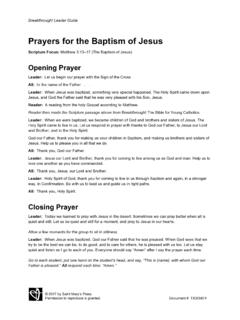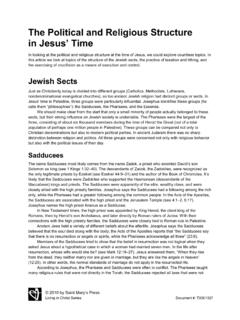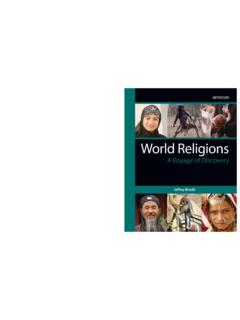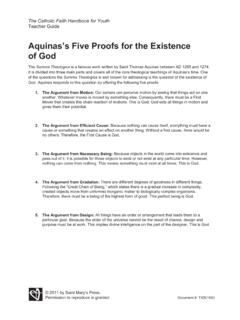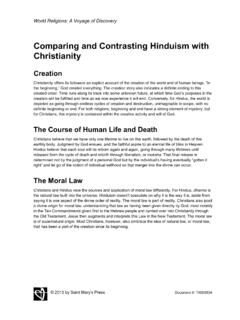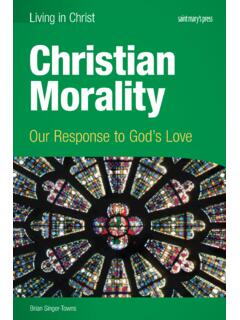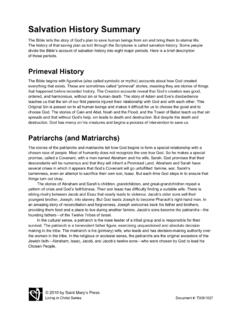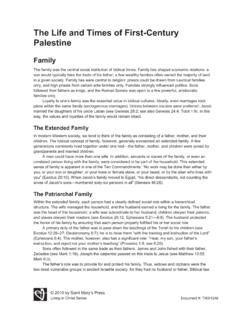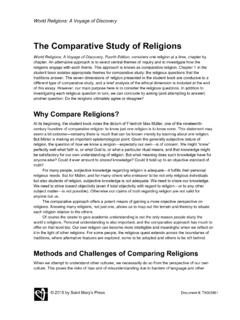Transcription of Bible 101: A Basic Introduction to the Word of God
1 2010 by Saint Mary s Press Living in Christ Series Document #: TX001000 Bible 101: A Basic Introduction to the Word of God In the Bible , which is also called the Sacred Scriptures, God speaks to us through human words . Through the Scriptures and Tradition, God not only reveals to us divine truth but God s very self. That is why we call both the Bible and jesus Christ (the Second Person of the Trinity) the Word of God. Through all the words of Sacred Scripture, God speaks with one single Word, his one Utterance in who he expresses himself completely (Catechism of the Catholic Church [CCC], 101).
2 The word Bible , is a derivative of the Greek word biblios, which simply means books. And that is the way we should think of the Bible , as a library of books that is divided into two parts: the Old Testament (before jesus ) and the New Testament (after jesus birth). The Old Testament The Old Testament closely parallels the scriptures of the Jewish faith (although the Catholic Old Testament contains additional books that are not part of the official Hebrew Scriptures). The Jewish people are called Hebrews, Israelites, Judeans, and Jews at various times in the Old Testament.
3 The Old Testament prepares us for the coming of jesus Christ, and its covenants (promises), laws, prophecies, and wisdom find their ultimate fulfillment in the life, Death, and Resurrection of Christ. Its books are typically grouped into these sections: The Pentateuch (a word meaning five books ) tells about the beginnings of God s Chosen People, the Israelites. You ll read about their early stories, their history, and the laws God gave them. The Historical Books pick up Israelite history from about 1250 BC to 100 BC.
4 You will find accounts of the Israelites settling the Promised Land, the rise and fall of their kings, their dispersion into Exile, and their eventual return to the Promised Land. The Wisdom and Poetry Books are a collection of hymns, poems, proverbs, and stories. They use imaginative language to make their points. The Prophets are people who speak God s Word. In the prophetic books, you will find the recorded prophecies and stories of sixteen of Israel s prophets (there were other prophets told about in other books too).
5 Their words contain condemnation of Israel s idolatry, false worship, and unjust practices. But they also offer many prophecies of comfort and promise for God s People, when they most needed to hear them. New Testament The New Testament tells the stories of jesus Christ s life, Death, and Resurrection and interprets the meaning of those stories for our salvation. Because jesus and his first followers were Jews, frequent quotations and allusions from the Jewish Scriptures (Old Testament) appear in the New Testament. The Old Testament prepares the way for the New, and the New Testament helps us to fully understand the meaning of the Old.
6 The New Testament is typically divided into these sections. Bible 101: A Basic Introduction to the Word of God Page | 2 2010 by Saint Mary s Press Living in Christ Series Document #: TX001000 The Gospels and the Acts of the Apostles. The Gospels (means Good News ) focus on the person and teachings of jesus . The four Gospels each offer a slightly different perspective on the meaning of Christ s life, Death, and Resurrection. Only with all four together do we get the most complete picture of jesus Christ, the Word of God.
7 The four Gospels occupy a central place because jesus Christ is their center (CCC, 139). The Acts of the Apostles was written by the same author who wrote the Gospel According to Luke. It shows how the Church was formed and how the first Christians spread the Good News, starting in Jerusalem and ending in Rome, the capital of the Roman Empire. These books cover 5 BC to the early AD 60s. The Letters. The Letters, or Epistles (some written by Paul and his followers, and others written by other Apostles or their followers), are actual letters that describe the new Christian faith, give advice, and offer words of hope to early Christians and the first Christian communities.
8 Sometimes this section is further divided into the Pauline letters, the Pastoral letters, and the Catholic letters. Revelation. The Revelation According to John is a collection of mystical visions written to encourage the early Christians, who were being persecuted by the Roman Empire. How Did We Get the Bible ? It would be nice to imagine that God gave us the Bible in one neatly bound book, but the actual process was more complicated than that! Scholars call the result the canon the official list of sacred books. The Development of the Old Testament At first, stories about Israel s history were passed on from generation to generation by word of mouth.
9 Around 1000 BC people started writing down these stories. The stories, along with laws and poetry, were gradually combined and edited, and the books, as we know them, began to take shape in the sixth century BC. Most of the Old Testament was written in Hebrew, but by the fourth century BC, Greek had become the most influential language, and many Jews could speak nothing else. During the third and second centuries BC, a Greek translation of the Hebrew Scriptures (the Septuagint) began to take shape. It has more books in it than the present Hebrew canon, which was established in the first century AD.
10 These books (called deuterocanonical) include Tobit, Judith, First and Second Maccabees, Wisdom, Sirach, Baruch, and additions to the books of Esther and Daniel. Most Protestant Bibles do not include these books, which Protestants call the Apocrypha. Many Protestants, however, still consider them spiritually useful. The Development of the New Testament The language jesus spoke was Aramaic, but the New Testament was written mainly in Greek. The oldest books in the New Testament are the letters of Paul; First Thessalonians probably was Paul s earliest letter (c.)
